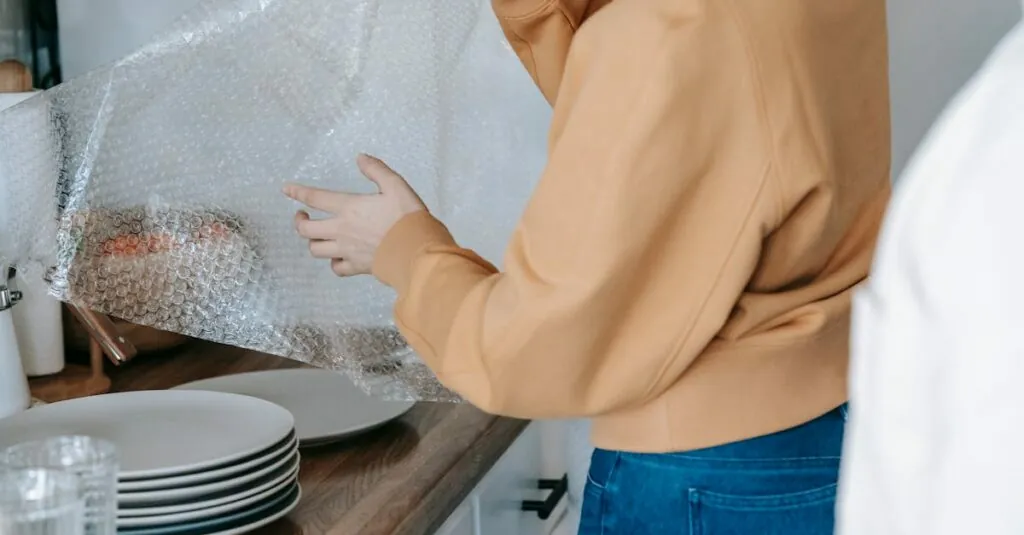Table of Contents
ToggleMoving can feel like a culinary game of Tetris, especially when it comes to packing up the kitchen. With pots and pans vying for space alongside fragile dishes and that mysterious appliance you never use, it’s easy to feel overwhelmed. But fear not! With a sprinkle of strategy and a dash of humor, packing your kitchen doesn’t have to be a recipe for disaster.
Preparing for the Move
Organizing the kitchen revolves around strategic assessment and preparation. Clearly organizing these tasks ensures a smoother packing process.
Assessing Your Kitchen Items
Start by categorizing items into essential, frequently used, and seldom used. Identify what must be packed first and what can be set aside until moving day. Consider donations for unused items that occupy valuable space. Label containers to help keep track of everything. Evaluate appliances too; prioritize small gadgets based on frequency of use. Create a clear inventory list to streamline packing later.
Gathering Packing Supplies
Use sturdy boxes in various sizes to accommodate different kitchen items. Acquire bubble wrap, packing paper, and tape to protect fragile dishes and glassware. Utilize dish towels or clothing for cushioning when needed. Gather markers for labeling boxes to simplify unpacking. Ensure you have the necessary tools like scissors and box cutters easily accessible. Choose durable bags for non-perishable food items so they stay fresh during the move.
Packing Techniques
Packing a kitchen requires strategic techniques to simplify the process. Utilizing effective methods helps ensure items remain safe and organized during the move.
Categorizing Kitchen Items
Start by categorizing kitchen items into essential, frequently used, and seldom used categories. This step helps in determining what gets packed first. Essential items, like utensils and dishware, should be prioritized for easy access after the move. Frequently used appliances, such as a toaster or blender, can be packed next. Seldom used items, like that waffle maker, can wait until closer to moving day. Use this categorization approach to streamline packing and minimize stress.
Efficient Packing Methods
Utilize efficient packing methods for optimal organization. Begin with sturdy boxes, preferably of similar sizes, to maximize space in moving vehicles. Wrap fragile items, including dishes and glassware, in bubble wrap or linens for added protection. Fill any empty space in boxes with packing paper or towels to prevent shifting during transport. Label each box clearly with its contents and designated kitchen area to make unpacking simpler. Group similar items together to find everything quickly at the new location.
Special Considerations
Packing a kitchen presents unique challenges. Preparing fragile items and handling appliances require careful attention.
Fragile Items
Fragile items demand extra care during the packing process. Use sturdy boxes, and line them with bubble wrap to provide cushioning. Wrap each fragile dish or glass in packing paper or bubble wrap individually to prevent breakage. Position heavy items at the bottom of boxes, placing lighter items on top. Label boxes containing fragile items clearly with “Fragile” to ensure careful handling. Unpacking these items first at the new location helps mitigate damage risks further.
Appliances and Electronics
Packing appliances and electronics needs a methodical approach. Disconnect all devices before packing to simplify the process. Use their original boxes if available, as they offer tailored protection. For larger appliances, like ovens and refrigerators, secure doors with tape to prevent them from opening during the move. Protect cords and accessories in labeled bags to keep everything organized. Unplugging and preparing ahead of moving day ensures a smoother transition to the new kitchen setup.
Unpacking Tips
Unpacking a kitchen can feel overwhelming, but with a structured approach, it becomes manageable. Prioritizing organization leads to efficiency and a smoother transition.
Organizing Your New Kitchen
First, empty boxes labeled as “Essential” contain the items needed right away. Arrange these items in designated spots to create an intuitive workflow. Place frequently used tools, such as knives and spatulas, in reachable drawers. Use cabinets for less frequently accessed items like serving ware. Designate a space for appliances, keeping them within easy reach yet out of the way. Labeling shelves can help in maintaining order, making it easier to navigate the new space.
Setting Up Efficiently
Setting up efficiently saves time and reduces stress. Start by arranging large items first, positioning pots and pans in accessible areas. Ensure counter space is clear to help facilitate food preparation. Position frequently used items near the stove to streamline cooking processes. Group similar items together, such as baking goods, cooking utensils, and dishes, to enhance accessibility. Utilizing vertical space with shelves and organizing tools can maximize storage, keeping your kitchen tidy and functional.
Packing a kitchen for a move doesn’t have to be a daunting task. With the right strategies in place it can be a straightforward process. By assessing and organizing items thoughtfully she can ensure that packing and unpacking goes smoothly.
Prioritizing essential items and using effective packing techniques will make a significant difference. Taking the time to protect fragile items and clearly labeling boxes can save a lot of headaches later on.
Once in the new space setting up the kitchen can be a breeze. Following a systematic approach allows for a seamless transition. With these tips in mind she can enjoy her new kitchen in no time.







